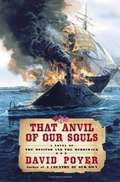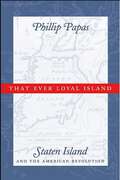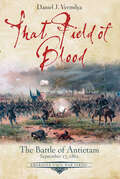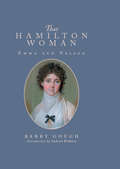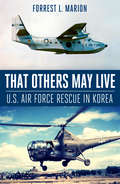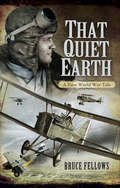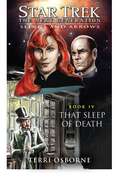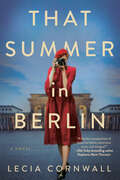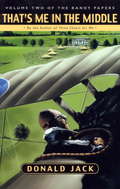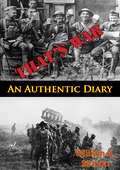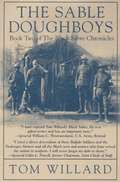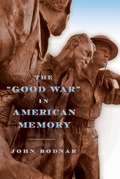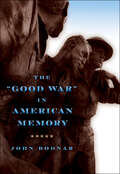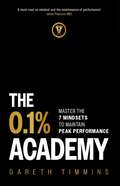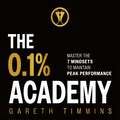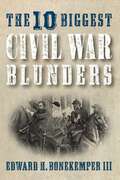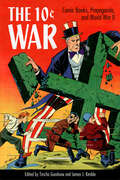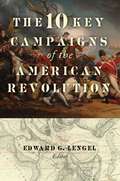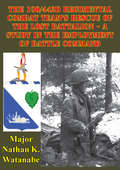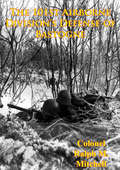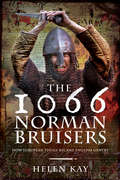- Table View
- List View
That Anvil of Our Souls: A Novel of the Monitor and the Merrimack (The Civil War at Sea #3)
by David PoyerIn the third volume of David Poyer's monumental Civil War at Sea cycle, North meets South in the momentous first battle between ironclads. We first met Elisha Eaker, Theodorus Hubbard, Araminta Van Velsor, Dr. Alphaeus Steele, Calpurnius Hanks, and Ker and Catherine Claiborne in Fire on the Waters, witnessing their unwilling but inescapable choosing of sides as America split into two nations. Then, In A Country of Our Own, Ker took the war to the North, as captain of the fastest, most heavily armed Confederate commerce raider ever to put to sea. Now, That Anvil of Our Souls takes us into the turrets and casemates of the most decisive sea engagement of the Civil War. In New York, Theo is the engineer for a revolutionary new "fighting machine" called the Monitor, and eager to become a man of means... so eager, a bribe compromises his integrity. In Norfolk, Catherine faces her husband's impending hanging for piracy, the death of their baby daughter, and the bitter realities of enemy occupation. In Richmond, Lt. Lomax Minter is ordered to find a spy who threatens the Souths ultimate weapon: a tremendous ironclad named Virginia, built from a sunken wreck in a race against time. While the aging Dr. Steele witnesses the horrors that are the aftermath of glory; and gun-captain Hanks, escaped slave, struggles with the demons of his past and the twin snakes of "freedom." Poyer's vivid characters join with meticulously researched historic figures to re-create the bloodiest conflict in American history-one whose reverberations will endure as long as freedom, equality, and home have different meanings in proud human hearts.
That Ever Loyal Island: Staten Island and the American Revolution
by Phillip PapasOf crucial strategic importance to both the British and the Continental Army, Staten Island was, for a good part of the American Revolution, a bastion of Loyalist support. With its military and political significance, Staten Island provides rich terrain for Phillip Papas's illuminating case study of the local dimensions of the Revolutionary War.Papas traces Staten Island's political sympathies not to strong ties with Britain, but instead to local conditions that favored the status quo instead of revolutionary change. With a thriving agricultural economy, stable political structure, and strong allegiance to the Anglican Church, on the eve of war it was in Staten Island's self-interest to throw its support behind the British, in order to maintain its favorable economic, social, and political climate. Over the course of the conflict, continual occupation and attack by invading armies deeply eroded Staten Island's natural and other resources, and these pressures, combined with general war weariness, created fissures among the residents of “that ever loyal island,” with Loyalist neighbors fighting against Patriot neighbors in a civil war. Papas’s thoughtful study reminds us that the Revolution was both a civil war and a war for independence—a duality that is best viewed from a local perspective.
That Field of Blood: The Battle of Antietam, September 17, 1862 (Emerging Civil War Series)
by Daniel VermilyaExplore the sites of the American Civil War’s Battle of Antietam and its history with this extensive guide.September 17, 1862—one of the most consequential days in the history of the United States—was a moment in time when the future of the country could have veered in two starkly different directions.Confederates under General Robert E. Lee had embarked upon an invasion of Maryland, threatening to achieve a victory on Union soil that could potentially end the Civil War in Southern Independence. Lee’s opponent, Major General George McClellan, led the Army of the Potomac to stop Lee’s campaign. In Washington D.C., President Lincoln eagerly awaited news from the field, knowing that the future of freedom for millions was at stake. Lincoln had resolved that, should Union forces win in Maryland, he would issue his Preliminary Emancipation Proclamation.All this hung in the balance on September 17: the day of the battle of Antietam.The fighting near Sharpsburg, Maryland, that day would change the course of American history, but in the process, it became the costliest day this nation has ever known, with more than 23,000 men falling as casualties.Join historian Daniel J. Vermilya to learn more about America’s bloodiest day, and how it changed the United States forever in That Field of Blood.“I highly recommend this book for anyone interested in the Battle of Antietam…. Vermilya is a fine author who has done a great service to this series.” —Gettysburg Chronicle“A meticulous and impressively informative read, That Field of Blood is a very highly recommended addition to personal, community, and academic library American Civil War History collections and supplemental studies lists.” —Midwest Book Review“A very good job presenting conclusions and providing a springboard for further discussion about the campaign and its historical consequences. That is what a good historian should do.” —Civil War News“Buy it, read it, think about it...then go to the battlefield. I've always stressed that standing in the very spot where significant historical events took place is essential when attempting to take in the full scale of the history. On the battlefield, That Field of Blood would make a great companion to the experience.” —The Rogue Historian
That Hamilton Woman: Emma and Nelson
by Barry GoughEmma Hamilton, much maligned by her contemporaries and later by historians and commentators, rose from the most humble beginnings to play a startling role in Britains naval victory over France and Spain in 1805. In this new book Barry Gough, employing the letters between the protagonists, and the unpublished examination of her career by famed American historian of the Royal Navy Arthur Marder, strongly defends Emma. He shows how this most talented of women and the beauty of her age fell victim to innuendo, slander and cruel caricature. She was to die in poverty in Calais in 1815, just months before Napoleons final defeat. Englands greatest sailor fell deeply in love with Emma in the years before Trafalgar. This, together with his quest for glory and victory entangled him in an inescapable web of circumstances and calumny. The author explores the evolving scandal, the high political stakes that were involved, and the love affair itself which so influenced the fortunes of Englands glory and the fate of her Wooden Walls. No novelist could have created such a tortuous scenario, charged as it was with high emotions, slurs, insults and slander. Richly illustrated throughout, the book shows Emma, probably the most painted woman of her age, in all her glories; it also shows how heartlessly caricaturists treated her. That Hamilton woman will long remain a controversial figure but here the author places her as one of the forces that gave the Royal Navy its will to fight and conquer. He depicts sympathetically a woman entrapped in circumstances of her own making, her saga reminding us of how frail is human fortune.
That Others May Live: Usaf Air Rescue In Korea (The\u. S. Air Force In Korea Ser.)
by Forrest L. MarionThat Others May Live, first published in 2004, is an overview of U.S. Air Force operations to rescue downed airmen on land and at sea during the Korean War (1950-1953). At the beginning of the conflict, the Air Rescue Service was in its infancy, but as the conflict grew, so did the success rate of the techniques used, and improvements to the aircraft employed by the service to successfully rescue hundreds of airmen. The book describes the types of helicopters and other aircraft used, the development of support bases, and details a number of rescue missions into enemy territory. Included are 12 pages of photographs and maps.
That Quiet Earth: A First World War Tale
by Bruce FellowsGeorge Bridge has a secret, a wrong he did a lifetime ago that he must confess. Back in the summer and autumn of 1918 he lived life at a pitch he never experienced again; any moment could have been his last. He was a pilot in the RAF.Day after day, George and his friend Billy Love fight for their lives. Just nineteen, they have everything to live for, but flying three miles above France, its kill or be killed and machine guns, Fokkers and a long burning fall haunt their dreams.At home their families wait; and so do their girls. Billy loves Jessica. Constance loves George. But who does George love?Then Billy flies into history and nothing is ever the same again.That Quiet Earth is rich in the kind of 'boys own' descriptions of combat that characterise this kind of fiction, but underlying the novel is an astute study of madness; the insanity of the war itself and the personal decline of tormented young Billy Love.As featured on BBC Radio Bristol and Clifton Life Magazine.
That Sleep of Death: Slings and Arrows #4 (Star Trek: The Next Generation #4)
by Terri OsborneA new six-part epic covering the first year of service of the U.S.S. Enterprise-E, leading up to the events of the hit movie Star Trek: First Contact. THAT SLEEP OF DEATH BOOK IV In the wake of increased concern over the Dominion threat, Dr. Beverly Crusher has attempted to improve morale on the Enterprise by starting up her theater company -- beginning with a production of A Christmas Carol. But before opening night, a devastating malady starts striking down the crew. Forced to rely on a piece of technology she despises -- the Emergency Medical Hologram -- Dr. Crusher must find a cure before it's too late!
That Summer in Berlin
by Lecia CornwallIn the summer of 1936, while the Nazis make secret plans for World War II, a courageous and daring young woman struggles to expose the lies behind the dazzling spectacle of the Berlin Olympics. German power is rising again, threatening a war that will be even worse than the last one. The English aristocracy turns to an age-old institution to stave off war and strengthen political bonds—marriage. Debutantes flock to Germany, including Viviane Alden. On holiday with her sister during the 1936 Berlin Olympics, Viviane&’s true purpose is more clandestine. While many in England want to appease Hitler, others seek to prove Germany is rearming. But they need evidence, photographs to tell the tale, and Viviane is a genius with her trusty Leica. And who would suspect a pretty, young tourist taking holiday snaps of being a spy? Viviane expects to find hatred and injustice, but during the Olympics, with the world watching, Germany is on its best behavior, graciously welcoming tourists to a festival of peace and goodwill. But first impressions can be deceiving, and it&’s up to Viviane and the journalist she&’s paired with—a daring man with a guarded heart—to reveal the truth. But others have their own reasons for befriending Viviane, and her adventure takes a darker turn. Suddenly Viviane finds herself caught in a web of far more deadly games—and closer than she ever imagined to the brink of war.
That Year of Our War
by Gloria GoldreichIn the tradition of Chaim Potok's The Chosen and Betty Smith's A Tree Grows in Brooklyn, That Year of Our War is a gentle, warmly nostalgic story by prizewinning author Gloria Goldreich about the final year of World War II and its profound consequences for a young woman and her extended family. For Sharon Grossberg, 1944 was a year of death and a year of birth. It began with D-Day, which for her would always mean "Death-Day," the day Sharon's mother died after a painful battle with leukemia. With Sharon's father in Europe serving as an army doctor, she is left in the care of her passionate, strong-willed aunts and uncles. Caught up in the varied currents of their lives, Sharon discovers the secrets of their marriages and is herself initiated into the mysteries of love and betrayal. There is Lottie, the eldest aunt and matriarch to whom they all turn first, and her husband, Julius, a wealthy furrier; Edna, the organizer and manager of the family, one of those women who know at once whom to call and what to do in every circumstance; and beautiful Dina, a social worker, and her husband, Robert, a Socialist artist. Transplanted from her Brookline, Massachusetts, home, Sharon spends the summer in Woodstock, New York, with her aunt Dina and uncle Robert. There Sharon experiences adult love for the first time and learns to accept the inevitable uncertainties one must face in life. It is a year during which birth and death converge, hope triumphs over despair, and the national tragedy of world war and the yearning for peace dominate thought and dream. Written with exquisite grace and subtlety, That Year of Our War is the compelling story of one family's loving and tenacious commitment to one another during those crucial months when love and loss, anxiety and exhilaration, hung in tense balance.
That's Me In The Middle
by Donald JackBartholomew Bandy has become an air ace. On the ground he causes disasters wherever he goes, but in the air he's deadly, shooting down dozens of German planes in the course of thrilling aerial combats. To the amazement of all who know him he becomes Lieut. Col. Bandy and thanks to his new rank he meets all sorts of people, including his fiancee's memorable family. As a handy (but disposable) war hero, he encounters a number of hair-raising adventures, not to mention English plumbing and an unforgettable honeymoon night. That's Me In The Middle is exciting, full of military action in the trenches and in the air, and, as it continues to flirt with history, very funny.
That’s War: An Authentic Diary
by William A. SirmonThat's War is a diary of the authentic experiences of Lt. William Arthur Sirmon from January 1, 1918 to November 12, 1918. In this account of a regular officer in the 82nd Division, 325th Infantry, you are led through ten chapters of a heartfelt, attention-grabbing journey. It starts out at Ft. Gordon, Georgia, where Sirmon was in charge of training soldiers. His story takes you across the beautiful, yet run down, terrain of France.William Arthur Sirmon spent more than four years prior to 1917 as an officer of the Philippine Constabulary, serving primarily in Mindanao, the "Island of Blood". He was the most highly decorated soldier from Georgia, and it is believed, of the entire Great War. February 16th, 1919, only he and Sergeant Alvin York were awarded The Legion of Honor of France, Distinguished Service Cross and the Croix de Guerre with Palm by General Pershing. These accolades made him an honorary citizen of England and France.This diary is not completely blood and guts, but surprisingly light for the most part. It describes the day-to-day life of typical American doughboys and the obstacles they faced through the entire war. That's War is a great read filled with excitement and humor, with education and entertainment throughout.--Print Ed.
The Sable Doughboys (Black Sabre #2)
by Tom WillardDuring the Great War, 404,348 African-Americans served in the army and navy. More than 200,000 African-American enlisted men and officers served in France. While the author of this novel has chosen to focus on the 93rd Division, specifically the 372nd Infantry Regiment, it should be noted that there were numerous Negro units, including the 92nd Division, that served with distinction during World War I. Distinctive combat service of the 92nd and 93rd divisions included their playing major roles in the battles of the Meuse-Argonne, the Champagne offensive, Château Thierry, the Vosges, Metz, and Alsace-Lorraine. On November 11, 1918, the day the armistice was signed, African-American troops of the 92nd Division were the soldiers closest to the Rhine, the river separating Germany from France. The people of France called these African-American soldiers ... the "Sable Doughboys."
The "Good War" in American Memory
by John BodnarThe "Good War" in American Memory dispels the long-held myth that Americans forged an agreement on why they had to fight in World War II. Looking back after more than half a century there seems little dispute that World War II was a 'good war', but at the time and for many decades after U.S. society was driven by an intense debate over why it had been necessary to enter such a conflict. This study explores the arguments.
The "Good War" in American Memory
by John BodnarThe "Good War" in American Memory dispels the long-held myth that Americans forged an agreement on why they had to fight in World War II. John Bodnar's sociocultural examination of the vast public debate that took place in the United States over the war's meaning reveals that the idea of the "good war" was highly contested.Bodnar's comprehensive study of the disagreements that marked the American remembrance of World War II in the six decades following its end draws on an array of sources: fiction and nonfiction, movies, theater, and public monuments. He identifies alternative strands of memory—tragic and brutal versus heroic and virtuous—and reconstructs controversies involving veterans, minorities, and memorials. In building this narrative, Bodnar shows how the idealism of President Franklin Roosevelt's Four Freedoms was lost in the public commemoration of World War II, how the war's memory became intertwined in the larger discussion over American national identity, and how it only came to be known as the "good war" many years after its conclusion.
The 0.1% Academy: Master the 7 Mindsets to Maintain Peak Performance
by Gareth TimminsWinning once is often achievable. Winning again and again, is where true greatness lies.Join The 0.1% Academy to learn how to maintain an elite mindset to consistently deliver a high performance and avoid burnout.Performance facilitator and elite mindset coach Gareth Timmins was one of only 0.1% of Royal Marines Commando applicants to reach the end of the intensive and gruelling training, and to earn the coveted Green Beret, a world-renowned symbol of excellence.By drawing on his life experiences after reaching this elite status, his subsequent research into psychological theory and observations from elite athletes, Timmins aims to break the commonly held assumption that people who achieve consistent successes, do so with ease. As if they are somehow unaffected mentally or emotionally by the events of everyday life. This book deconstructs the attributes of a growth mindset, highlighting the positive and negative fluidity of thinking that can affect anyone - even at the highest level - if we don't actively manage our wellbeing. By exploring a typical cycle of 7 different mindsets with a raw and honest approach, you will better understand how to sustain mental toughness and high performance in a professional capacity at work or in sport, and avoid the cognitive pitfalls that can lead to goal derailment. In doing so, The 0.1% Academy challenges the notion that 'resilience remains resilient'.Packed with proven, practical applications for building, maintaining and regaining cognitive performance, you can apply the lessons in the book to establish the correct prescription of thinking, avoid pitfalls and maintain successful professional outcomes for longer. Such an approach will not only help individuals to enhance their performance but enrich corporate and team environments too.
The 0.1% Academy: Master the 7 Mindsets to Maintain Peak Performance
by Gareth TimminsWinning once is often achievable. Winning again and again, is where true greatness lies.Join The 0.1% Academy to learn how to maintain an elite mindset to consistently deliver a high performance and avoid burnout.Performance facilitator and elite mindset coach Gareth Timmins was one of only 0.1% of Royal Marines Commando applicants to reach the end of the intensive and gruelling training, and to earn the coveted Green Beret, a world-renowned symbol of excellence.By drawing on his life experiences after reaching this elite status, his subsequent research into psychological theory and observations from elite athletes, Timmins aims to break the commonly held assumption that people who achieve consistent successes, do so with ease. As if they are somehow unaffected mentally or emotionally by the events of everyday life. This book deconstructs the attributes of a growth mindset, highlighting the positive and negative fluidity of thinking that can affect anyone - even at the highest level - if we don't actively manage our wellbeing. By exploring a typical cycle of 7 different mindsets with a raw and honest approach, you will better understand how to sustain mental toughness and high performance in a professional capacity at work or in sport, and avoid the cognitive pitfalls that can lead to goal derailment. In doing so, The 0.1% Academy challenges the notion that 'resilience remains resilient'.Packed with proven, practical applications for building, maintaining and regaining cognitive performance, you can apply the lessons in the book to establish the correct prescription of thinking, avoid pitfalls and maintain successful professional outcomes for longer. Such an approach will not only help individuals to enhance their performance but enrich corporate and team environments too.
The 0.1% Academy: Master the 7 Mindsets to Maintain Peak Performance
by Gareth TimminsWinning once is often achievable. Winning again and again, is where true greatness lies.Join The 0.1% Academy to learn how to maintain an elite mindset to consistently deliver a high performance and avoid burnout.Performance facilitator and elite mindset coach Gareth Timmins was one of only 0.1% of Royal Marines Commando applicants to reach the end of the intensive and gruelling training, and to earn the coveted Green Beret, a world-renowned symbol of excellence.By drawing on his life experiences after reaching this elite status, his subsequent research into psychological theory and observations from elite athletes, Timmins aims to break the commonly held assumption that people who achieve consistent successes, do so with ease. As if they are somehow unaffected mentally or emotionally by the events of everyday life. This book deconstructs the attributes of a growth mindset, highlighting the positive and negative fluidity of thinking that can affect anyone - even at the highest level - if we don't actively manage our wellbeing. By exploring a typical cycle of 7 different mindsets with a raw and honest approach, you will better understand how to sustain mental toughness and high performance in a professional capacity at work or in sport, and avoid the cognitive pitfalls that can lead to goal derailment. In doing so, The 0.1% Academy challenges the notion that 'resilience remains resilient'.Packed with proven, practical applications for building, maintaining and regaining cognitive performance, you can apply the lessons in the book to establish the correct prescription of thinking, avoid pitfalls and maintain successful professional outcomes for longer. Such an approach will not only help individuals to enhance their performance but enrich corporate and team environments too.
The 0.1% Academy: Master the 7 Mindsets to Maintain Peak Performance
by Gareth TimminsWinning once is often achievable. Winning again and again, is where true greatness lies.Join The 0.1% Academy to learn how to maintain an elite mindset to consistently deliver a high performance and avoid burnout.Performance facilitator and elite mindset coach Gareth Timmins was one of only 0.1% of Royal Marines Commando applicants to reach the end of the intensive and gruelling training, and to earn the coveted Green Beret, a world-renowned symbol of excellence.By drawing on his life experiences after reaching this elite status, his subsequent research into psychological theory and observations from elite athletes, Timmins aims to break the commonly held assumption that people who achieve consistent successes, do so with ease. As if they are somehow unaffected mentally or emotionally by the events of everyday life. This book deconstructs the attributes of a growth mindset, highlighting the positive and negative fluidity of thinking that can affect anyone - even at the highest level - if we don't actively manage our wellbeing. By exploring a typical cycle of 7 different mindsets with a raw and honest approach, you will better understand how to sustain mental toughness and high performance in a professional capacity at work or in sport, and avoid the cognitive pitfalls that can lead to goal derailment. In doing so, The 0.1% Academy challenges the notion that 'resilience remains resilient'.Packed with proven, practical applications for building, maintaining and regaining cognitive performance, you can apply the lessons in the book to establish the correct prescription of thinking, avoid pitfalls and maintain successful professional outcomes for longer. Such an approach will not only help individuals to enhance their performance but enrich corporate and team environments too.
The 10 Biggest Civil War Blunders
by Edward H. BonekemperWhat makes the Civil War so fascinating is that it presents an endless number of "what if" scenarios—moments when the outcome of the war (and therefore world history) hinged on a single small mistake or omission. In this book, Civil War historian Edward Bonekemper highlights the ten biggest Civil War blunders, focusing in on intimate moments of military indecision and inaction involving great generals like Robert E. Lee, Ulysses S. Grant, and William T. Sherman as well as less effective generals such as George B. McClellan, Benjamin Butler, and Henry W. Halleck. Bonekemper shows how these ten blunders significantly affected the outcome of the war, and explores how history might easily have been very different if these blunders were avoided.
The 10 Cent Chocolate Tub
by Mike Mcgann10 Cent Chocolate Tub will take you back to the 1950's and 1960s when life was uncomplicated. There were three channels to watch on a black and white television set showing Sid Caesar, Bishop Fulton J. Sheen, Howdy Doody, Milton Berle, fifteen minutes of Nat King Cole, The Lone Ranger and The Toast of The Town. Radio stations were AM only and played Elvis Presley, Doo-Wop music, Frank Sinatra, Doris Day, Patti Page, Chubby Checker and The Four Seasons, long before The Beatles came to America. The small things in life were exciting to a city boy who grew up to be a broadcaster, a Vietnam veteran, a minor performer and a dad! Everyone has family stories, crazy relatives, funny incidents, memories of how good things were back then and dreams of how they should be. The 10 Cent Chocolate Tub gets it's name from a huge chocolate ice cream cone sold by Bard's Dairy in the 1950s in Pittsburgh at a time when a young boy, who wore rummage sale clothes and ate surplus cheese, was only allowed a nickel vanilla ice cream now and then. This is about the quest for life's finer things like ice cream anytime you want it, playing the radio loudly, crying at a sad movie, falling in love, heartbreaks, kissing your children goodnight and loving every minute of it.
The 10 Cent War: Comic Books, Propaganda, and World War II
by Trischa Goodnow and James J. KimbleContributions by Derek T. Buescher, Travis L. Cox, Trischa Goodnow, Jon Judy, John R. Katsion, James J. Kimble, Christina M. Knopf, Steven E. Martin, Brad Palmer, Elliott Sawyer, Deborah Clark Vance, David E. Wilt, and Zou YizhengOne of the most overlooked aspects of the Allied war effort involved a surprising initiative--comic book propaganda. Even before Pearl Harbor, the comic book industry enlisted its formidable army of artists, writers, and editors to dramatize the conflict for readers of every age and interest. Comic book superheroes and everyday characters modeled positive behaviors and encouraged readers to keep scrapping. Ultimately, those characters proved to be persuasive icons in the war's most colorful and indelible propaganda campaign.The 10 Cent War presents a riveting analysis of how different types of comic books and comic book characters supplied reasons and means to support the war. The contributors demonstrate that, free of government control, these appeals produced this overall imperative. The book discusses the role of such major characters as Superman, Wonder Woman, and Uncle Sam along with a host of such minor characters as kid gangs and superhero sidekicks. It even considers novelty and small presses, providing a well-rounded look at the many ways that comic books served as popular propaganda.
The 10 Key Campaigns of the American Revolution
by Edward G. LengelMany American know bits and pieces of the War for Independence…Lexington, Bunker Hill, Saratoga, Yorktown, Washington, Hamilton, Benedict Arnold. All familiar names, but how did it all fit together. How did merchants, lawyers, farmers and cobblers all come together and defeat the combined forces of the British Empire, its powerful Navy, and their Hessian auxiliaries. For that matter, who were the Hessians, and what is an auxiliary? Eminent historian, Ed Lengel has brought together ten of the most highly respected Revolutionary War experts to present the stirring narratives of history altering military campaigns that formed a new nation. Accessibly written, the lay reader will take a tour through British America from Quebec City's frozen fortress, to the Concord's Old North Bridge, Cross the Delaware with Washington and through South Carolina with the "Swamp Fox" Frances Marion. After reading these ten riveting essays, every American will sound like an expert on our nation's fight for freedom. Includes: Lexington, Concord, and Bunker Hill by Glenn Williams Quebec and the Champlain Valley by Mark Anderson Brooklyn to Fort Lee by Todd Braisted The Crossing and The Ten Crucial Days by William L. Kidder Ticonderoga To Saratoga by James Kirby Martin Brandywine to Valley Forge by Michael C. Harris The Monmouth Campaign by Mark Lender Charlestown to Kings Mountain by John Buchanan From Cowpens to Guilford Courthouse by John Maass The Allied March to Yorktown by Robert Selig
The 100/442D Regimental Combat Team's Rescue of the Lost Battalion: A Study in the Employment of Battle Command
by Major Nathan K. WatanabeThis thesis examines the application of battle command during the 100/442d Regimental Combat Team's rescue of the First Battalion, 141st Infantry Regiment, 36th Infantry Division, the "Lost Battalion." As background, this study presents a brief history of the Japanese in Hawaii and the United States, of the formation and record of the 100/442d RCT, and of the battle to rescue the Lost Battalion. The contemporary concept of battle command is defined as per Army Field Manual 3-0, Operations (June 2001) and Field Manual 22-100, Leadership; Be, Know, Do (August 1999) and shown to encompass the World War II-era concepts of command and leadership.This study examines how the tenets of battle command-visualize, describe, direct-were applied by the 36th Division and the 100/442d RCT during the operation. Specific examples from the battle will illustrate both the use and neglect of the precepts of battle command and illustrate the importance of sound command and leadership techniques as well as the value of unit cohesion in present-day operations.
The 101st Airborne Division’s Defense Of Bastogne [Illustrated Edition]
by Colonel Ralph M. Mitchell[Includes 53 photos/illustrations and 11 maps]The defense of Bastogne during the Battle of the Bulge in World War II is one of the supreme achievements of American arms. Bastogne is deservedly identified with the finest characteristics of the American soldier, and the name Bastogne symbolizes a heroic battle. Bastogne has long held the attention of students of war, yet the battle offers new insights for soldiers with modern concerns.Colonel Ralph M. Mitchell's study, The 101st Airborne Division's Defense of Bastogne, reveals how a light infantry division, complemented by key attachments, stopped an armor-heavy German corps. Using original documents and reports, Colonel Mitchell traces the fight at Bastogne with emphasis on the organization, movement and, employment of the 101st Airborne Division. Although a variety of factors influenced the outcome at Bastogne, the flexibility of the 101st to reconfigure for sustained operations and to defeat strong opposition forces even when surrounded shows how properly augmented light infantry can fight and win.
The 1066 Norman Bruisers: How European Thugs Became English Gentry
by Helen KayThe fascinating story of the social evolution of William the Conqueror’s invaders and the generations that followed: “A great book.” —Medieval Sword SchoolThe 1066 Norman Bruisers conjures up the vanished world of England in the late Middle Ages and casts light on one of the strangest quirks in the nation’s history: how a bunch of European thugs became the quintessentially English gentry. In 1066, go-getting young immigrant Osbern Fitz Tezzo crossed the Channel in William the Conqueror’s army. Little did he know that it would take five years to vanquish the English, years in which the Normans suffered almost as much as the people they had set out to subdue. For the English, the Norman Conquest was an unmitigated disaster, killing thousands by the sword or starvation. But for Osbern and his compatriots, it brought territory and treasure—and a generational evolution they could never have imagined. This book follows successive descendants as they fought for monarchs and magnates, oversaw royal garrisons, traveled abroad as agents of the crown, and helped to administer the laws of the land. When they weren’t strutting across the stage of northwestern England, mingling with great men and participating in great events, they engaged in feuds, embarked on illicit love affairs, and exerted their influence in the small corner of the country they had made their own. The 1066 Norman Bruisers represents both a fascinating family history and a riveting journey through post-Conquest England.
